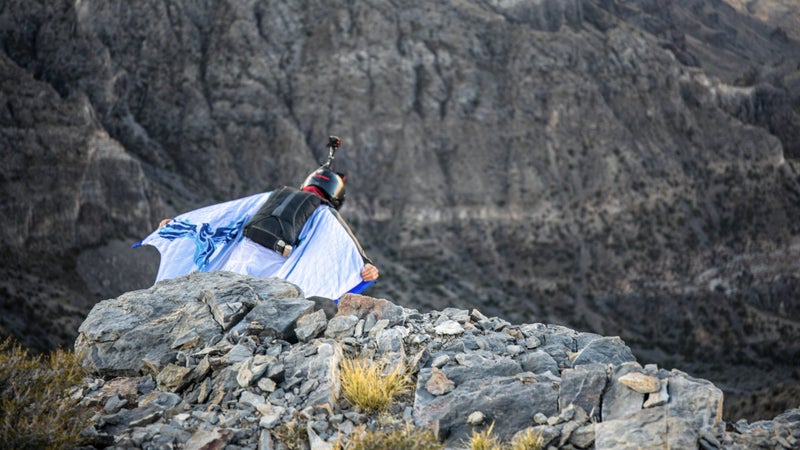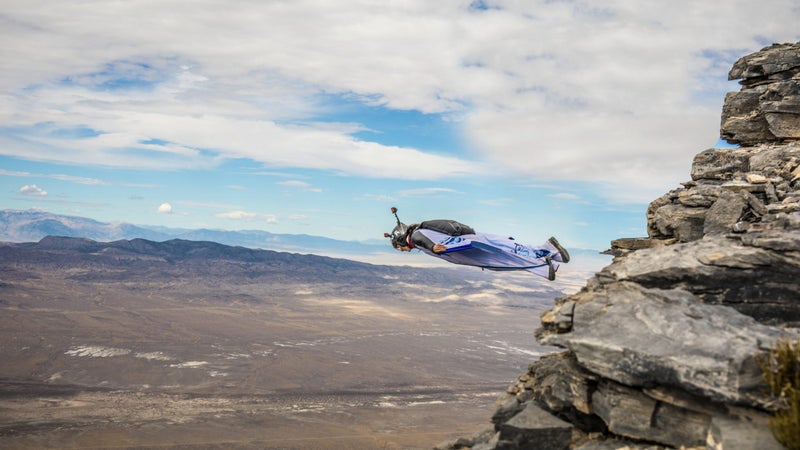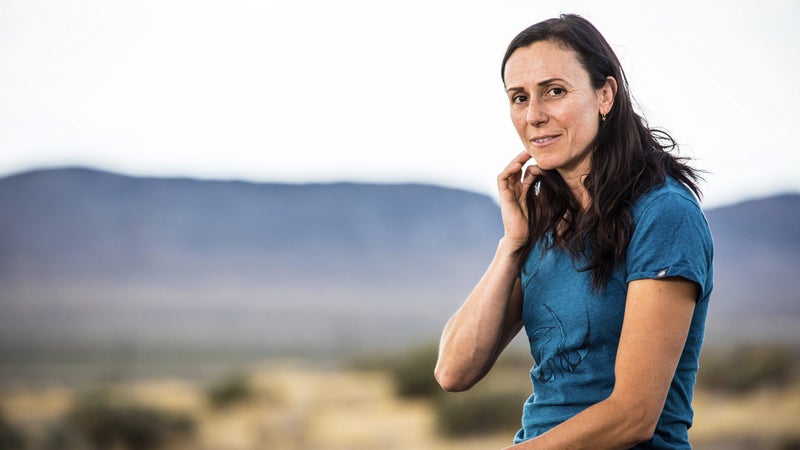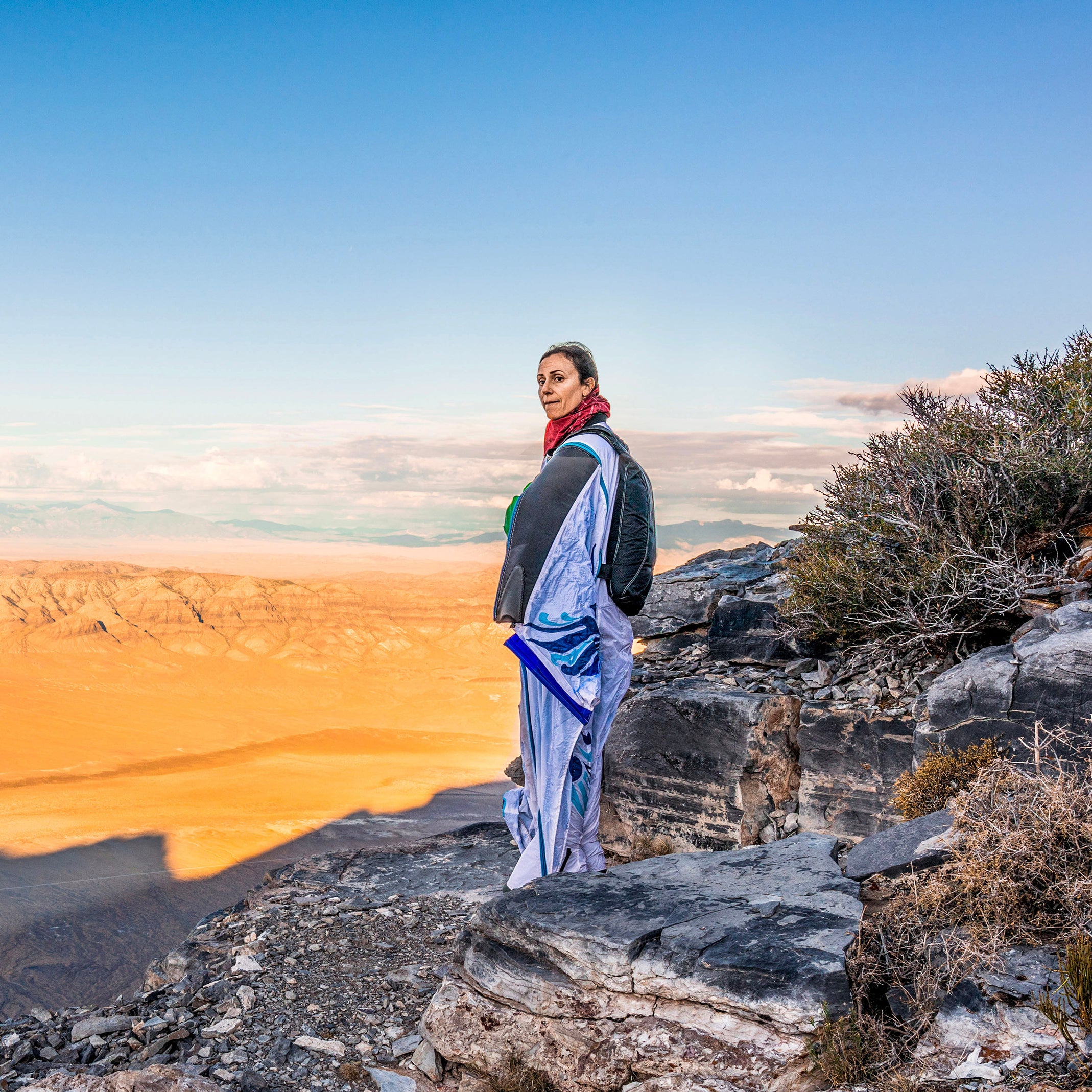Several years ago, climber, BASE jumper, and wingsuit pilot Steph Davis embarked on an ambitious adventure in the West Desert of southern Utah. Bone-dry and accented by rugged, remote mountain ranges, the West Desert is, as tour guides say, “very different from other parts of the state.” There are few roads. Few towns. And even fewer campgrounds. The Bonneville Salt Flats, a 30,000-acre cracked-earth pancake so barren that not even the simplest life forms can exist there, fan across the area.
From the small town of Delta, Davis and her husband, Mario Richard, drove 140 miles on isolated roads until the dirt road became impassable. From there, they hiked a rocky wash and climbed up a narrowing canyon that led them to their objective: the northwest prow of Notch Peak. Rising 4,450 feet from the desert floor, with a sheer and uninterrupted 2,000-foot-high face, it’s the second-tallest vertical cliff face in America, second only to El Cap.
With Davis leading, she and Richard climbed all 12 of the limestone pitches on the vertical face. At 2 p.m., they reached the summit, but topping out wasn’t the finale. High up in the cool air, Davis and Richard traded climbing harnesses for wingsuits, walked to the monolith’s edge, leaned out, and leapt into the void. As Davis began falling through the air, she assumed the position of a flying squirrel. For almost a minute, she soared over the desert’s starkly beautiful terrain, before deploying her parachute and maneuvering it down to land in the rugged gravel wash they’d walked up eight hours earlier.
The sequence of events above could easily make for one of those epic, make-your-palms-sweat scenes in a climbing film. For Davis, it was a Tuesday in the middle of a busy week that would include several other forms of adventure. Ever since she was a student at Colorado State University, in Fort Collins, the 45-year-old adventurer has consistently knocked off record-breaking feat after record-breaking feat in multiple outdoor disciplines.
Over the past two decades, Davis has logged a ticker tape of first ascents and notable climbs. She was the first woman to free-climb the Salathė Wall, on El Capitan (5.13 VI, 35 pitches), and first to free solo the infamous Diamond route on Longs Peak. She’s also made first ascents in Baffin Island, Patagonia, Pakistan, and Kyrgyzstan.
When you’re someone like me, doing a lot of free soloing in no-fall environments, it’s hard to feel good about falling.
Many of Davis’s most impressive feats were “free solos”—that is, climbing the wall without a rope or harness. “When you’re someone like me,” says Davis, “doing a lot of free soloing in no-fall environments, it’s hard to feel good about falling,” she says. “The thought is if I fall, I die, and it can become inhibiting to think that way as a climber.” Rather than let those thoughts and fears interfere with her climbing, she decided to face them head-on: by falling, literally, from the sky.
She jumped out of her first plane, over Longmont, Colorado, in June 2007. Her first BASE jump—off Idaho’s Perrine Bridge, spanning the Snake River—followed months later. Her knack for extreme focus contributed to her “accelerated progression,” and soon she was seeking out features she could jump off near her home in Moab.

BASE stands for “buildings, antennas, spans, and earth,” and the earth features around her hometown—sandstone spires and short cliffs—were too low to be safe for a new jumper. To learn her craft, she went to Europe, where the cliffs are taller, and soon she was back in Moab, concentrating most of her attention on parachuting from cliffs and increasing her skills with a wingsuit. Between 2008 and 2012, she found a way to combine her sports by doing several notable BASE climbs around Moab—climbing to the tops of spires and jumping off—then, seeking still more opportunity for “absolute commitment,” she found a site suitably high to add wingsuiting into the mix.
For Davis, the laser focus required to climb at such a high level, BASE jump, and wingsuit is what she calls a “superpower,” allowing her to push out the noise of the modern world and reach clarity in her life. It’s how she defeats what she calls the “attention merchants” of the modern world—Twitter and Facebook, the never-ending stream of news, fake news, Instagrams, and updates that constantly disrupt our daily lives. “As soon as you tune in to this, you become very protective of your attention,” she says. “I decided that I wasn’t going to give mine away anymore, because whatever you put your attention in is where you’re going to go.”

Wingsuiting has only further honed Davis’s superpowers. “If you do a longer free climb, it can take a couple of hours. To maintain focus for that long is really intense,” she explains. “So when I get to the top, I have this euphoric experience. It’s probably serotonin—and relief at not having to focus anymore.” But a climb with a flight allows for no release of happy brain chemicals at the top. Instead of “mentally going into Disneyland and happily wandering back down” at the top, she must maintain a superhuman level of concentration until she completes her flight and is safely back on the ground.
The most important thing in life is to bring joy into the world, and that comes from people who are joyful
The highs associated with safely executing all of the physical and mental skills required to climb and wingsuit at Davis’s level can feel out-of-body, but so can the lows. Over the course of her career, Davis has not escaped pain. She has lost two husbands to wingsuiting. Her second, Mario Richard, died wingsuiting with her in the Italian Dolomites in 2013. A few years later, her ex-husband, legendary climber Dean Potter, died in a wingsuit accident in Yosemite National Park. The fact that Davis continues to wingsuit, or that people choose to wingsuit at all, might be hard for some people to comprehend. Davis understands this, but to stop doing the things she loves wouldn’t make any sense to her, either. “The most important thing in life is to bring joy into the world, and that comes from people who are joyful,” she says. “I don’t want to die anytime soon, and I’ve been doing extreme sports for over half my life. I try to be as careful as I can, and I also understand there’s only so much I can control.”
At this point in her career, she’s mostly interested in “doing what’s right. What lights you up.” She lives simply in the vast Utah desert and has “an abiding suspicion of [traditional] luxury.” Her luxuries are “quietness, cleanliness, open space, firewood, sunrises and sunsets, and time to watch them.” Lately, she’s also begun spending more time trying to teach and inspire others to do the same.

In addition to exploring and guiding, she runs women’s climbing clinics in Moab and Indian Creek, Utah. The focus is on “teaching them skills and techniques that will make them safer,” but it’s about much more than that: She also instills her sense of beauty, simplicity, and passion. “Steph is clearly a gifted athlete, but what sets her apart is how rooted she is in sharing her outdoor knowledge,” says Rob Layer, brand manager at one of her sponsors, Backcountry. “She is driven to inspire others to get outside with confidence.”
People who take one of Steph’s classes come away with all sorts of practical knowledge, from why they should always tie a knot in the end of their rope when rappelling off a route to how to put their hand in the rock and make it stick. The more powerful takeaways, and the ones Davis says ultimately resonates the most with her students, is to do what makes you happy and remember that, as she likes to say, the only thing you can count on is yourself.
Garmin supports everyone who explores the outdoors and follows their passions. The Garmin Women of ���ϳԹ��� series celebrates the women who inspire us through their physical feats, fearlessness and advocacy in action. Discover more stories .

